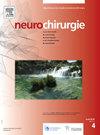术前颈椎对准参数可以预测术后失能评分和脊髓病结局。
IF 1.4
4区 医学
Q4 CLINICAL NEUROLOGY
引用次数: 0
摘要
目的:本研究旨在探讨行前路颈椎椎体切除融合术(ACCF)治疗的颈椎病患者术前颈椎对准与术后脊髓病变变化的关系。方法:采用颈椎前路椎体切除术和融合手术治疗颈椎病的患者纳入研究。我们在手术前评估了各种颈椎对准参数,如T1矢状角、T1斜率和C2-7矢状垂直轴(SVA)。采用改良日本骨科协会评分(mJOA)、颈部残疾指数(NDI)和视觉模拟量表(VAS)评估术后脊髓病的预后。采用Pearson相关系数和多元线性回归进行统计学分析,确定术前影像学参数与术后临床预后的关系。结果:单节段椎体切除术组和多节段椎体切除术组在年龄、性别和BMI方面无显著差异。术后C2-7 Cobb角、手术时间、出血量差异均有统计学意义。C2-7 SVA较高的患者手术效果较差。结论:术前颈椎线对测量如T1斜率和C2-7 SVA可能有助于预测ACCF手术后脊髓病的预后。预测术后患者的临床结果对于准备术后护理和调整治疗非常重要。本文章由计算机程序翻译,如有差异,请以英文原文为准。
Preoperative cervical alignment parameters can predict postoperative disability scores and myelopathy outcomes
Purpose
This study aims to investigate the relationship between preoperative cervical spine alignment and changes in postoperative myelopathy after surgery in patients with cervical myelopathy who underwent anterior cervical corpectomy and fusion (ACCF) surgery as treatment.
Methods
Patients who underwent anterior cervical corpectomy and fusion surgery for the treatment of cervical myelopathy were included in the study. We evaluated various cervical alignment parameters such as T1 sagittal angle, T1 slope, and C2–7 sagittal vertical axis (SVA) before surgery. Postoperative myelopathy outcomes were assessed using the Modified Japanese Orthopedic Association score (mJOA), Neck Disability Index (NDI), and Visual Analog Scale (VAS). Statistical analysis was performed using Pearson correlation coefficient and multiple linear regression to determine the relationship between preoperative radiological parameters and postoperative clinical outcomes.
Results
There were no significant differences in age, gender, or BMI between the single-level and multilevel corpectomy groups. Significant differences were observed in postoperative C2–7 Cobb angle, operative time, and blood loss. Patients with higher C2–7 SVA had worse operative outcomes.
Conclusion
Preoperative cervical alignment measurements such as T1 slope and C2–7 SVA may be helpful in predicting myelopathy outcomes after ACCF surgery. Predicting the clinical outcomes of the patient after surgery is important for preparing postoperative care and adjusting treatment.
求助全文
通过发布文献求助,成功后即可免费获取论文全文。
去求助
来源期刊

Neurochirurgie
医学-临床神经学
CiteScore
2.70
自引率
6.20%
发文量
100
审稿时长
29 days
期刊介绍:
Neurochirurgie publishes articles on treatment, teaching and research, neurosurgery training and the professional aspects of our discipline, and also the history and progress of neurosurgery. It focuses on pathologies of the head, spine and central and peripheral nervous systems and their vascularization. All aspects of the specialty are dealt with: trauma, tumor, degenerative disease, infection, vascular pathology, and radiosurgery, and pediatrics. Transversal studies are also welcome: neuroanatomy, neurophysiology, neurology, neuropediatrics, psychiatry, neuropsychology, physical medicine and neurologic rehabilitation, neuro-anesthesia, neurologic intensive care, neuroradiology, functional exploration, neuropathology, neuro-ophthalmology, otoneurology, maxillofacial surgery, neuro-endocrinology and spine surgery. Technical and methodological aspects are also taken onboard: diagnostic and therapeutic techniques, methods for assessing results, epidemiology, surgical, interventional and radiological techniques, simulations and pathophysiological hypotheses, and educational tools. The editorial board may refuse submissions that fail to meet the journal''s aims and scope; such studies will not be peer-reviewed, and the editor in chief will promptly inform the corresponding author, so as not to delay submission to a more suitable journal.
With a view to attracting an international audience of both readers and writers, Neurochirurgie especially welcomes articles in English, and gives priority to original studies. Other kinds of article - reviews, case reports, technical notes and meta-analyses - are equally published.
Every year, a special edition is dedicated to the topic selected by the French Society of Neurosurgery for its annual report.
 求助内容:
求助内容: 应助结果提醒方式:
应助结果提醒方式:


